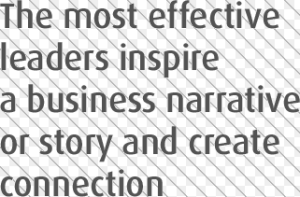 In business, the future narrative is becoming vital. We all should care about the future and it becomes so important for us all to identify or not, as this gives us our identification.
In business, the future narrative is becoming vital. We all should care about the future and it becomes so important for us all to identify or not, as this gives us our identification.
I have found that narratives are becoming increasingly important to explain ‘things’. I’m re-learning this ‘art’ to tell a compelling story.
Our stories can combine much, communities can identify or reject, we can begin to explain complex stories by presenting a well-designed narrative that presents the arguments. It can explain the connections and outline the issues, both in terms of risk and opportunity.
I think business narratives will become essential for our organizations to use to explain where they are and what they see as their future.
A good business narrative should fill a real knowledge gap
Organizations by making this move to open up, to spend more time explaining their ‘fit’ in the world will gain. Those that stay closed down, secretive and selective in what they reveal will continue to ebb away and not valued as important for our future.
 The business narrative is argued as the way to seek increased identity, allows a broader community to enact, to extract better cues for their sense of identity and offer a better way to draw them into this greater sense of identification.
The business narrative is argued as the way to seek increased identity, allows a broader community to enact, to extract better cues for their sense of identity and offer a better way to draw them into this greater sense of identification.
I wrote about visualizing the innovating future through narrative reporting here and placing the business model as central to this narrative movement here.
We are in a constant state of being adaptive
We live in such a fluid world where we are all being forced constantly to be adaptive. It seems nothing is standing still and if it does it simply gets knocked down. We are all learning this new practice of being nimble and increasingly adaptive. Part of the growing complexity we all are grappling with daily is in the multiple voices that are competing for our attention.
Social platforms and having available the so many easy tools to participate are everywhere. This has liberated these millions of voices wanting to express themselves. Cutting through these competing voices to sort out those that are relevant to you or the ones that will move you to action are tough. We need to go one step further.
We all feel the effects of this ‘sucking of time’ out of our days. We need to build a greater sense of connection, understanding the broader connectivity to put ‘things’ in context.
The story or narrative will increasing make the final connection and cut through this growing distraction noise. Getting more focused on the context and explaining this through a good narrative or story is becoming essential to go beyond ‘just a connection’ into prompting real identification and even action.
Anchoring ourselves through stories will help us regain that lost middle ground.
What we need to do, is anchor all these seemingly competing voices into our stories to explain where we are, where we believe we should be going and what, as we presently know it, will help us get there.
Learning the art of good narratives is becoming essential to tell our story and its place to help reduce conflicts and misunderstandings and help us all to navigate a little better in this more complex world.
We can tell these organizations stories in so many compelling ways, through the business model, and through sustainability reporting. A well-structured business narrative can offer the organization vision, it can enhance communication, it can highlight where the organization is critically capturing knowledge and putting it to work.
We need to spark more.
Narratives can spark our thinking in how this can encourage innovation and growth, so as to build a growing sense of community and identification, of engagement and identification. As new knowledge comes into us we need to increasingly sort it, to identify the relevant ‘tags’ and assign them in importance to us, our community and to the broader context.
Mastering the business narrative is becoming critical, in helping to connect the innovations we need to build our future and these need to be more connected by the power of the story.
Moving beyond just the sound bite or tweet
Our lives must move beyond the ‘sound bites’, they give us a feeling of engagement but this can be fleeting, lost in microseconds, we need to gain a greater sense of community and that comes from connecting the fragments of a story and piecing them together to give more lasting meaning. We need the ‘greater’ context, not just fleeting moments.
Business leaders need to practice the art (and science) of describing aspects that might be complex, into good narratives so we can identify with these and recognize ways we can contribute and support.
Paul, thank you for explaining the importance of business narratives especially those focused on the future. I began working as a commercial storyteller in 2007, and it’s exciting and gratifying to see the world catching up and catching on to the relevance of story to business. And you’re absolutely right: narrative provides a framework for wrestling with complexity, making it visible, meaningful and memorable – all pre-requisites for effective action. Some of my posts at KILN address commercial storytelling in innovation, which you may have seen. There is a standalone site about my approach at http://www.storyform.co.uk and you may find something of value there. I’d sure love your thoughts, Paul.